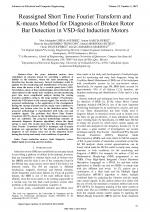| 2/2019 - 8 |
| Extra paper information in |
| Click to see author's profile in |
| Download PDF |
Author keywords
induction motors, fault diagnosis, rotors, digital signal processing, spectral analysis
References keywords
induction(27), motors(20), detection(15), fault(13), rotor(11), industrial(10), diagnosis(10), broken(10), electronics(9), systems(8)
Blue keywords are present in both the references section and the paper title.
About this article
Date of Publication: 2019-05-31
Volume 19, Issue 2, Year 2019, On page(s): 61 - 68
ISSN: 1582-7445, e-ISSN: 1844-7600
Digital Object Identifier: 10.4316/AECE.2019.02008
Web of Science Accession Number: 000475806300008
SCOPUS ID: 85066316496
Abstract
Over the years induction motors have established an uncanny knack for providing a plethora of utilities in the industry, where the fault monitoring and detection has become necessary. Several techniques could be applied for the monitoring and identification of broken rotor bars when the motor is fed by a variable speed drive (VSD). Nevertheless, many of these methodologies detect this fault and other failures in the steady state condition, but this monitoring grow into more complicated analysis during the startup transient condition owing to the large number of harmonics, which the VSD insert to the current signal. The novelty of the proposed methodology is the application of the reassignment during the startup transient and the steady state conditions to identify one broken rotor bar in the induction motor. The proposed methodology is experimented with both, real and synthetic signals. The problems that Short Time Fourier Transform (STFT), shows for the identification of broken rotor bars are exhibited. The proposed methodology includes an automatic diagnosis (K-means algorithm), where the signal energy is used. The results show that the Reassigned Short Time Fourier Transform (RSTFT) technique and K-means methods are appropriated for the effective monitoring and diagnosis of one broken rotor bar in the induction motor during the startup and steady state conditions of operation. |
| References | | | Cited By |
Web of Science® Times Cited: 4 [View]
View record in Web of Science® [View]
View Related Records® [View]
Updated 3 weeks, 2 days ago
SCOPUS® Times Cited: 5
View record in SCOPUS® [Free preview]
View citations in SCOPUS® [Free preview]
[1] Experimental Study on Drilling Signal Characteristics of PDC Drill Bit in Media of Different Strengths and Identification of Weak Media, Wu, Zheng, Fan, Yingbo, Chen, Huazhou, Sensors, ISSN 1424-8220, Issue 23, Volume 24, 2024.
Digital Object Identifier: 10.3390/s24237852 [CrossRef]
[2] RUL Prediction of Switched Mode Power Supply Using a Kalman Filter Assisted Deep Neural Network, Kwon, Jae Eon, Shifat, Tanvir Alam, Kareem, Akeem Bayo, Hur, Jang-Wook, Processes, ISSN 2227-9717, Issue 1, Volume 10, 2021.
Digital Object Identifier: 10.3390/pr10010055 [CrossRef]
[3] Current Park’s Vector Pattern Technique for Diagnosis of Broken Rotor Bars Fault in Saturated Induction Motor, Abdellah, Chaouch, Mama, Chouitek, Meflah Abderrahmane, Mohamed Reda, Mohammed, Belaid, Journal of Electrical Engineering & Technology, ISSN 1975-0102, Issue 4, Volume 18, 2023.
Digital Object Identifier: 10.1007/s42835-022-01342-6 [CrossRef]
Disclaimer: All information displayed above was retrieved by using remote connections to respective databases. For the best user experience, we update all data by using background processes, and use caches in order to reduce the load on the servers we retrieve the information from. As we have no control on the availability of the database servers and sometimes the Internet connectivity may be affected, we do not guarantee the information is correct or complete. For the most accurate data, please always consult the database sites directly. Some external links require authentication or an institutional subscription.
Web of Science® is a registered trademark of Clarivate Analytics, Scopus® is a registered trademark of Elsevier B.V., other product names, company names, brand names, trademarks and logos are the property of their respective owners.
Faculty of Electrical Engineering and Computer Science
Stefan cel Mare University of Suceava, Romania
All rights reserved: Advances in Electrical and Computer Engineering is a registered trademark of the Stefan cel Mare University of Suceava. No part of this publication may be reproduced, stored in a retrieval system, photocopied, recorded or archived, without the written permission from the Editor. When authors submit their papers for publication, they agree that the copyright for their article be transferred to the Faculty of Electrical Engineering and Computer Science, Stefan cel Mare University of Suceava, Romania, if and only if the articles are accepted for publication. The copyright covers the exclusive rights to reproduce and distribute the article, including reprints and translations.
Permission for other use: The copyright owner's consent does not extend to copying for general distribution, for promotion, for creating new works, or for resale. Specific written permission must be obtained from the Editor for such copying. Direct linking to files hosted on this website is strictly prohibited.
Disclaimer: Whilst every effort is made by the publishers and editorial board to see that no inaccurate or misleading data, opinions or statements appear in this journal, they wish to make it clear that all information and opinions formulated in the articles, as well as linguistic accuracy, are the sole responsibility of the author.



